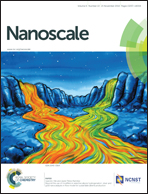Bioinspired polyethylene terephthalate nanocone arrays with underwater superoleophobicity and anti-bioadhesion properties†
Abstract
This paper presents a facile method to fabricate bioinspired polyethylene terephthalate (PET) nanocone arrays via colloidal lithography. The aspect ratio (AR) of the nanocones can be finely modulated ranging from 1 to 6 by regulating the etching time. The samples with the AR value of 6 can present underwater superoleophobicity with the underwater oil contact angle (OCA) of 171.8°. The as-prepared PET nanocone arrays perform anti-bioadhesion behavior, which inhibits the formation of the actin cytoskeleton when it used as the substrate for cell culture. Moreover, the oil wettability is temperature controlled after modifying the PET nanocone arrays with PNIPAAm film, and the oil wettability of the functionalized nanocone arrays can be transformed from the superoleophobic state with OCA about 151° to the oleophilic state with OCA about 25° reversibly. Due to the high-throughput, parallel fabrication and cost-efficiency of this method, it will be favourable for researchers to introduce oleophobic properties to various substrate and device surfaces. Due to the superoleophobicity and simple functionalizing properties, the PET nanocone arrays are very promising surfaces for anti-adhesion, self-cleaning and have potential applications in material, medical, and biological fields.


 Please wait while we load your content...
Please wait while we load your content...